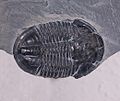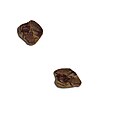Category:Wheeler Shale
Jump to navigation
Jump to search
geologic formation in Utah notable for trilobite fossils | |||||
| Upload media | |||||
| Instance of | |||||
|---|---|---|---|---|---|
| Location | Utah | ||||
 | |||||
| |||||
English: The Wheeler Shale (named by Charles Walcott) is a Cambrian (c. 507 Ma) fossil locality world famous[1] for prolific agnostid and Elrathia kingii trilobite remains (even though many areas are barren of fossils)[2] and represents a Konzentrat-Lagerstätten. Varied soft bodied organisms are locally preserved, a fauna (including Naraoia, Wiwaxia and Hallucigenia) and preservation style (carbonaceous film) normally associated with the more famous Burgess Shale.[3] As such, the Wheeler Shale also represents a Konservat-Lagerstätten.[4]
Together with the Marjum Formation and lower Weeks Formation, the Wheeler Shale forms 490 to 610 m (1,600 to 2,000 ft) of limestone and shale exposed in one of the thickest, most fossiliferous and best exposed sequences of Middle Cambrian rocks in North America.[5]
At the type locality of Wheeler Amphitheater, House Range, Millard County, western Utah, the Wheeler Shale consists of a heterogeneous succession of highly calcareous shale, shaley limestone, mudstone and thin, flaggy limestone.[6] The Wheeler Formation (although the Marjum & Weeks Formations are missing) extends into the Drum Range, northwest of the House Range where similar fossils and preservation are foundSubcategories
This category has the following 4 subcategories, out of 4 total.
Media in category "Wheeler Shale"
The following 18 files are in this category, out of 18 total.
-
Asaphiscuswheelerii.jpg 1,040 × 878; 124 KB
-
Chancelloria eros fossil, Middle Cambrian, Millard County UT.jpg 523 × 1,778; 1.47 MB
-
Elrathia kingii Dyet 2174.jpg 640 × 640; 23 KB
-
ElrathiaKingi.jpg 630 × 760; 135 KB
-
ElrathiakingiUtahWheelerCambrian.jpg 2,892 × 3,576; 8.89 MB
-
Itagnostus interstrictus (White, 1874) - 8 mm 1.JPG 4,272 × 2,848; 7.56 MB
-
Itagnostus interstrictus (White, 1874) - 8 mm 2 (cropped).jpg 2,048 × 3,537; 5.37 MB
-
Itagnostus interstrictus (White, 1874) - 8 mm 2.jpg 4,272 × 2,848; 7.99 MB
-
Itagnostus interstrictus (White, 1874) - 8 mm.JPG 4,272 × 2,848; 6.95 MB
-
Itagnostus interstrictus (White, 1874).JPG 4,272 × 2,848; 6.31 MB
-
Peronopsis interstrictus White, 1874 2 (cropped).jpg 1,679 × 2,709; 3.9 MB
-
Peronopsis interstrictus White, 1874 2.jpg 3,856 × 2,624; 8.43 MB
-
Peronopsis interstrictus White, 1874 3.jpg 3,952 × 2,512; 7.18 MB
-
Peronopsis interstrictus White, 1874.jpg 4,288 × 2,848; 11.4 MB
-
Ptychagnostus gibbus 1.jpg 1,984 × 1,288; 290 KB
-
Ptychagnostus gibbus 2.jpg 1,976 × 1,208; 298 KB
Categories:
- Cambrian formations in the United States
- Geologic formations in Utah
- Geologic formations of the United States
- Shales
- Shale formations in the United States
- Limestone formations in the United States
- Mudstone formations in the United States
- Sedimentology of Utah
- Sedimentary rocks in Utah
- Fossil bearing geologic formations in the United States
- Wheeler Formation
















